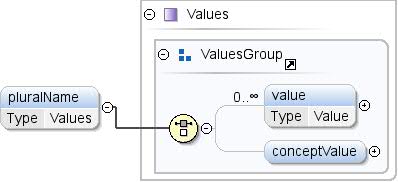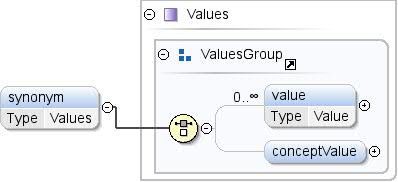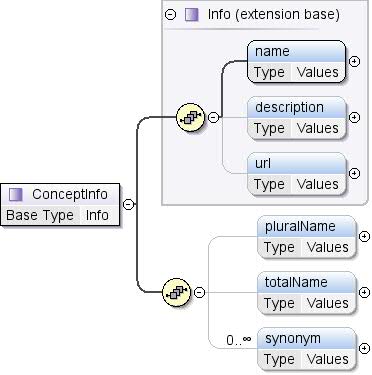Komponente: ConceptInfo
Mit Sammlungen den Überblick behalten
Sie können Inhalte basierend auf Ihren Einstellungen speichern und kategorisieren.
| Namespace |
http://schemas.google.com/dspl/2010 |
| Annotationen |
Ein Name, der auf eine Sammlung von Instanzen des
(z.B. pluralName von "State" ist
„Bundesstaaten“). |
| Diagramm |
 |
| Typ |
Werte |
| Attribute |
| content: |
komplex |
| minOccurs (Mindestanzahl): |
0 |
|
| Modell |
Wert* | conceptValue{0,1} |
| Children |
conceptValue, Wert |
| Instanz |
<pluralName>
<value lang="">{0,unbounded}</value>
<conceptValue concept="">{0,1}</conceptValue>
</pluralName>
|
| Quelle |
<xs:element name="pluralName" type="Values" minOccurs="0">
<xs:annotation>
<xs:documentation>A name used to refer to a collection of instances of
the concept (e.g., pluralName of "State" is "States").</xs:documentation>
</xs:annotation>
</xs:element>
|
| Namespace |
http://schemas.google.com/dspl/2010 |
| Annotationen |
Ein Name, der sich auf alle Instanzen des Konzepts bezieht (z.B.
totalName für „Bundesstaat“ ist „All US“). |
| Diagramm |
 |
| Typ |
Werte |
| Attribute |
| content: |
komplex |
| minOccurs (Mindestanzahl): |
0 |
|
| Modell |
Wert* | conceptValue{0,1} |
| Children |
conceptValue, Wert |
| Instanz |
<totalName>
<value lang="">{0,unbounded}</value>
<conceptValue concept="">{0,1}</conceptValue>
</totalName>
|
| Quelle |
<xs:element name="totalName" type="Values" minOccurs="0">
<xs:annotation>
<xs:documentation>A name used to refer to all the instances of the
concept (e.g., totalName for "State" is "All US").</xs:documentation>
</xs:annotation>
</xs:element>
|
| Namespace |
http://schemas.google.com/dspl/2010 |
| Annotationen |
Mit diesem Synonym
Konzept. |
| Diagramm |
 |
| Typ |
Werte |
| Attribute |
| content: |
komplex |
| minOccurs (Mindestanzahl): |
0 |
| maxOccurs: |
unbegrenzt |
|
| Modell |
Wert* | conceptValue{0,1} |
| Children |
conceptValue, Wert |
| Instanz |
<synonym>
<value lang="">{0,unbounded}</value>
<conceptValue concept="">{0,1}</conceptValue>
</synonym>
|
| Quelle |
<xs:element name="synonym" type="Values" minOccurs="0" maxOccurs="unbounded">
<xs:annotation>
<xs:documentation>A synonym that can be used to refer to this concept.</xs:documentation>
</xs:annotation>
</xs:element>
|
Komplexer Typ: ConceptInfo
| Namespace |
http://schemas.google.com/dspl/2010 |
| Annotationen |
Textinformationen zu einem Konzept im Dataset. Dieses
Erweiterung des base Info-Typs werden einige zusätzliche Felder hinzugefügt, die nur
auf Konzepte anwenden können. |
| Diagramm |
 |
| Typ |
Erweiterung von Info |
| Typhierarchie |
|
| Verwendet von |
|
| Modell |
name , description{0,1} , url{0,1} , pluralName{0,1} , totalName{0,1} , Synonym* |
| Children |
description, name, pluralName,
Synonym, totalName, url |
| Quelle |
<xs:complexType name="ConceptInfo">
<xs:annotation>
<xs:documentation>Textual information about a concept in the dataset. This extension of
the base Info type adds a few additional fields that only apply to
concepts.</xs:documentation>
</xs:annotation>
<xs:complexContent>
<xs:extension base="Info">
<xs:sequence>
<xs:element name="pluralName" type="Values" minOccurs="0">
<xs:annotation>
<xs:documentation>A name used to refer to a collection of instances of
the concept (e.g., pluralName of "State" is "States").</xs:documentation>
</xs:annotation>
</xs:element>
<xs:element name="totalName" type="Values" minOccurs="0">
<xs:annotation>
<xs:documentation>A name used to refer to all the instances of the
concept (e.g., totalName for "State" is "All US").</xs:documentation>
</xs:annotation>
</xs:element>
<xs:element name="synonym" type="Values" minOccurs="0" maxOccurs="unbounded">
<xs:annotation>
<xs:documentation>A synonym that can be used to refer to this concept.</xs:documentation>
</xs:annotation>
</xs:element>
</xs:sequence>
</xs:extension>
</xs:complexContent>
</xs:complexType>
|
Erstellt mit dem
oXygen XML Editor
Sofern nicht anders angegeben, sind die Inhalte dieser Seite unter der Creative Commons Attribution 4.0 License und Codebeispiele unter der Apache 2.0 License lizenziert. Weitere Informationen finden Sie in den Websiterichtlinien von Google Developers. Java ist eine eingetragene Marke von Oracle und/oder seinen Partnern.
Zuletzt aktualisiert: 2025-07-25 (UTC).
[null,null,["Zuletzt aktualisiert: 2025-07-25 (UTC)."],[],["The core content describes the \"ConceptInfo\" element, which extends the base \"Info\" type and provides textual information about a concept. Key actions involve defining names for collections of concept instances using `pluralName` (e.g., \"States\"), referring to all instances with `totalName` (e.g., \"All US\"), and specifying `synonym` for alternative concept names. `pluralName`, `totalName`, and `synonym` use complex `value` or `conceptValue`. ConceptInfo also contains `name`, `description` and `url`.\n"]]



